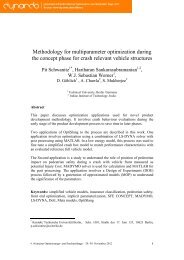multiPlas - Dynardo GmbH
multiPlas - Dynardo GmbH
multiPlas - Dynardo GmbH
Create successful ePaper yourself
Turn your PDF publications into a flip-book with our unique Google optimized e-Paper software.
This model guaranties a consistent dissipation of fracture energy during the softening process for different<br />
sizes of elements. The stress-strain lines available in <strong>multiPlas</strong> are shown in Fig. 3-13. Thereby, a linear<br />
elastic behaviour is assumed until the tensile strength is reached. After that, one of the following is<br />
assumed as consequence of tensile fracturing:<br />
** linear softening until the strain limit is reached εtr (mlaw = 0, 2) or<br />
** exponential softening (mlaw = 1)<br />
σ<br />
Fig. 3-13 Stress-strain relation in <strong>multiPlas</strong> (mlaw=0, 2; mlaw = 1)<br />
For the exponential softening model (mlaw = 1) one should assume<br />
G E<br />
h ≤ (3-24)<br />
f<br />
f<br />
2<br />
t<br />
Über h gemittelte Spannungs-Dehnungslinie<br />
f t<br />
f t/E<br />
(a)<br />
(b)<br />
"Snap-Back", wenn h groß<br />
ε tr<br />
h PR h<br />
for the length h in order to avoid the numerically unstable „snap-back“ phenomena. This is preferably<br />
achieved by choosing a proper mesh size. In <strong>multiPlas</strong>, the equivalent length will calculated automatically.<br />
(a)<br />
(b)<br />
h PR<br />
19<br />
USER’S MANUAL, January, 2013<br />
h<br />
ε






